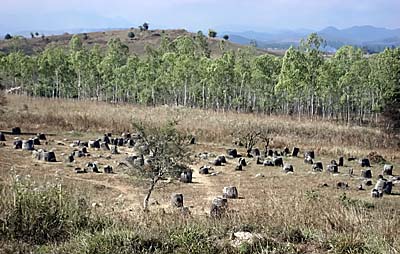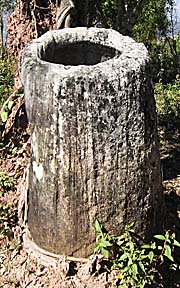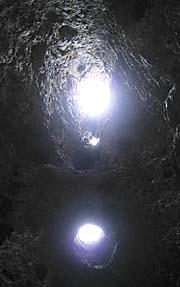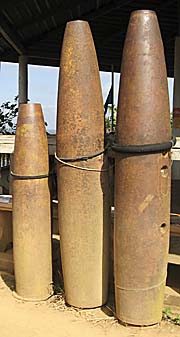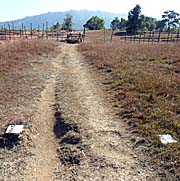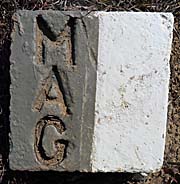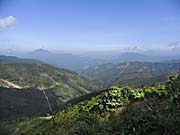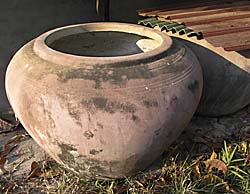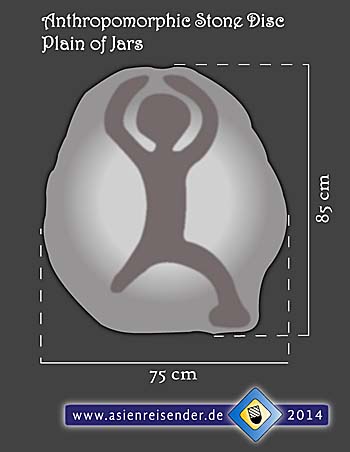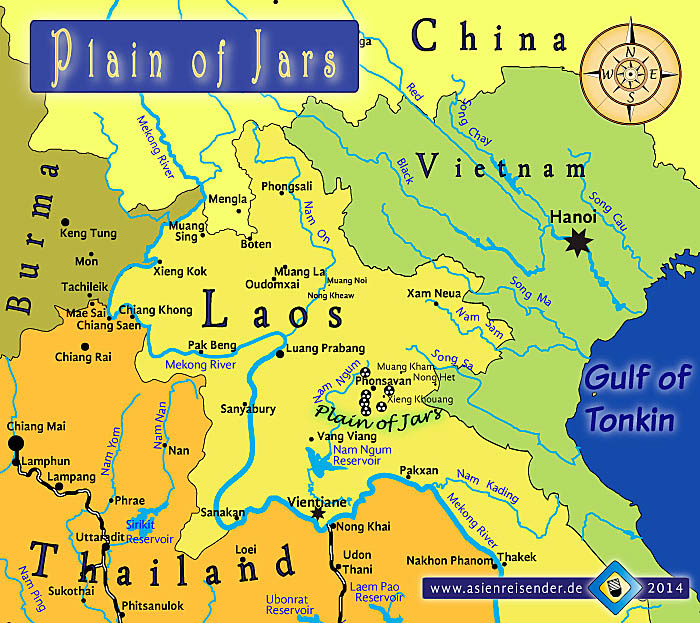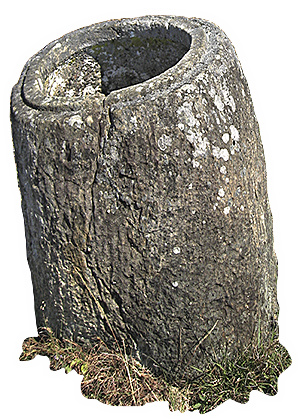4.
Havoc and Unexploded Ordnance
The jars have been exploited since a long time. A French archeologist in the 1920s wrote already that the villagers around were plundering the jars for pieces they could sell; the kids were curious of things to find they could play with. Whole urns got smashed, because the locals believed to find precious content inside. Many jars had been broken already. Besides, who knows what for treasure hunters (tomb raiders) have been there in all the centuries before?!

Many of the jars are damaged for the most different reasons. The one at the left might have been smashed by locals, for they use parts of them for different purposes. The one in the middle got victim to a tree who's remaining piece of trunk is still sticking inmiddle of the bursted jar. Image by Asienreisender, 2006
The tooth of time is nagging at the jars. Their surface is very rough - in the original state they were certainly smooth. Erosion due to weather conditions happens. The temperature differences between hot summer noons and cold winter nights are also a strain for the material in the long run. Slash and burn happens around the jars. Cattle are scrubbing their horns at them. Plants start growing in cracks in the urns and, growing bigger and stronger, causing harm to them, sometimes even bursting them.
Sometimes jars or parts of them are used for building purposes in the villages. Jars are used as filling for fundaments of new roads. A great number of different damages are done by the peasants who use the jars for different purposes - and consume them. For example as wetstones for their knifes.
Whole jars have been undigged and transported away, to surrounding villages, to Vientiane or even into the USA - as a souvenir from the brave war in Indochina, presented by the Hmong general Vang Pao.
Whatever the purposes of the jars in the past were, now they found a new, modern purpose: as dustbins for the litter tourists drop at the sights.
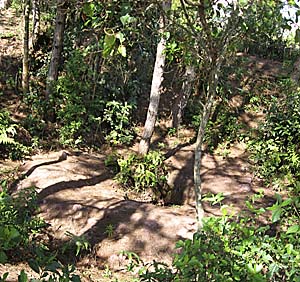
A bomb crater at site no. 2. Concluding from the size it could have been a 'bomby'. Image by Asienreisender, 2006
In the American Vietnam War the US Air Force dropped 260 million cluster bombs on Laos (see also the article 'Bombs on Laos'); the greatest aerial bombardement in the history of warfare targeted also very much the Plain of Jars. These cluster bombs opened in the air and released a number of bigger explosives and 300 smaller ones (bomblets). About a third of them didn't explode when falling on the ground. But they are still explosive. If they get moved, shaken or stepped on they act like landmines. They are no failure, but were designed to behave so. They are also programmed to tear off arms or legs or damage eyes rather than to kill. The calculation is, that a wounded enemy is a burden for the enemy population, for others have to spend resources, time and energy to care for him/her, and he/she is itself unable to support war efforts. The Laotians call the small bomblets 'bombies'.
A great number of the jars have been destroyed in the bombardments. One can find fractions of jars and many huge bomb craters around. Madeleine Colani counted around 10,000 jars and catalogued them according to the villages of her time. 20 villages on the Plain of Jars have vanished in the American Vietnam War. Till now 3,000 jars have been relocated after the war.
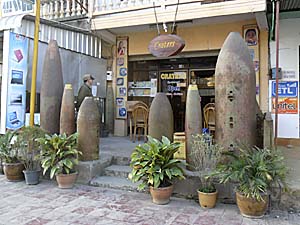
"Craters" is a 'bombastic' restaurant in Phonsavan. Bombshells and the horrors of war as a marketing idea. Image by Asienreisender, 11/2011
Moreover, a great number of people have been killed and millions of the bombs remained unexploded (UXO) and provide a high live risk for anyone who walks around in the area appart from the cleared areas. Annually still 300 people die due to UXO accidents in Laos. Many of the victims are children, until today.
The former province capital, Xieng Khouang, has been completely destroyed in the war. The capital was therefore moved to Phonsavan after 1975.
From 2004 on international organizations started to clear parts of the Plain of Jars from UXO. Still, most of the area is mined and not save to go. The most visited sites 1 (Ban Ang), 2 and 3 are mainly cleared. There are certain marked paths one has to walk on only and must not leave. Behind the marks nothing can be guaranteed. The Plain of Jars are one of the most dangerous sights on earth.
That is also the reason why further exploration is impeded, at least delayed, until more clearing is done. The clearing, undertaken by different international institutions, has never been supported by the USA.
The war's legacy will probably never been cleared completely and find many more victims over the next generations.
